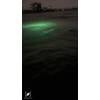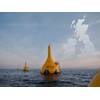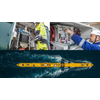An ASL Acoustic Zooplankton Fish Profiler (AZFP) will soon be travelling to the U.K. to be deployed in the strong tidal waters off the coast of Wales (Figure 1). While AZFP's are regularly deployed around the world, this usage is free of charge, the result of a successful application to ASL's AZFP Award Program for early-career scientists.
Although there were other deserving applicants for the Program, Dr. Timothy Whitton from the Centre for Applied Marine Sciences at Bangor University succeeded to draw our attention for his proposed study on the biological processes in areas of marine renewable energy development. Dr. Whitton will get the use of a 125, 200, 455 and 769 kHz instrument for four months free of charge starting in September 2016 to conduct his research. This will build on and progress research conducted by him during the SEACAMS project that collaborated with the Welsh marine renewable sector.
With the development of marine renewable energy (namely tidal and wave) gaining momentum in Welsh waters, understanding the physical and ecological characteristics and process in these high current and coastal areas will prove critical. Dr. Whitton aims to do just that, focusing particularly on the important micronekton group of organisms that can be conduits of energy transfer between the seabed and water column and between trophic levels. Having the ability to acquire high-resolution observations over spring/neap tidal cycles will enhance Dr. Whitton's understanding on how diel periods, tidal velocity and turbidity may interact with vertical migratory behavior of different groups of organisms. The wide range of frequencies on the AFZP will allow the observation of fish, zooplankton, and even sediments over the relevant time periods. The sea-bottom mounted AZFP will also enhance this research by removing the problem of ship generated turbulence and bubble entrainment due to bow-mounted transducers, which can create noise – an issue common to areas of high tidal currents and sea swell.

















 December 2025
December 2025



